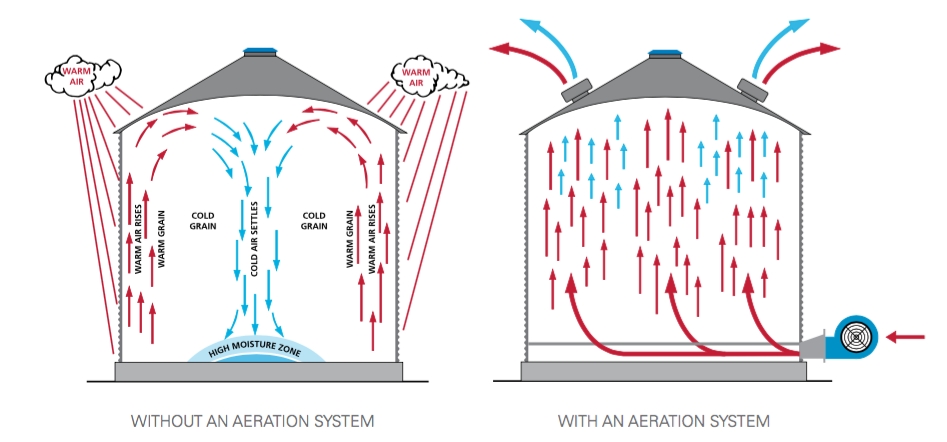
Storage & Transport
Spring moisture migration in grain bins
Safe storage of grain on farm is a key to successful farm management. Harvested grain may be put into bins at acceptable moisture contents, but is it safe? Knowing what temperature and moisture contents are acceptable is critical for the safe storage of grain. The following information sheds some light on what to watch for in stored grain during springtime conditions.
More stored grain goes out of condition or spoils due to lack of temperature control than for any other reason. It cannot be emphasized enough that the control of temperature in a bin of stored grain is absolutely critical. Geographically in Western Canada, we are located in a region where we get North America’s most severe temperature fluctuations from one season to the next. The transition between these extremes can happen rapidly or gradually. It is during these transition periods when stored grain is most at risk, due to a phenomenon called moisture migration. Moisture migration happens inside the bin when the difference in grain temperature and the outside air is the most extreme.
Properly drying and cooling your grain in the fall is crucial to preserving grain quality through the fall and winter months, and well into spring. If your grain was harvested in hot, dry conditions in the fall you must be careful to bring down the temperature of that grain to enable safe storage through the winter. Likewise, if due to weather conditions at harvest time you have put your grain in the bin at a higher moisture content than usual, you must also be careful to lower the temperature to a point where you can safely store the grain over the winter.
As outside temperatures begin to rise in springtime, continued monitoring of your grain bins is required. In spring, as the ambient temperature of the air outside the bin starts to warm up the bin wall also tends to warm, which in turn warms the adjacent grain. This results in the air adjacent to the bin wall warming up as well. At this point the warm air creates a moisture current that moves upward through the grain on the outside perimeter of the grain mass. As this air warms up and starts to move, it will pick up moisture from the grain and carry it upwards. As the moistened air nears the top of the bin, it moves toward the center where it encounters cooler grain temperatures. This air cools down and starts to move down the center of the bin, laden with the moisture it accumulated during the upwards cycle along the bin wall. During this part of the cycle the air starts to release this moisture.
The lower the air migrates in the bin, the more moisture it will give off. Therefore, high moisture due the condensation of the cooling air occurs at the bottom center of the bin. In and around this area of high moisture you can expect grain spoilage to occur.
If grain is to be stored in the bin for any length of time it is important to bring the grain temperature up to a point that will prevent the abovementioned from happening. In order to accomplish this, it is recommended that the grain temperature in the bin be raised to approximately 10 C. It is important as a producer to consult safe storage charts that will show what length of time you can store the grain at its’ current moisture and temperature, continued monitoring is vital.
Aeration (warming) at this point should be accomplished with .05 to .1 cfm/ bus, and only until the desired, uniform temperature is achieved throughout the bin. From this point forward going into warmer temperatures, the temperature of the grain should be monitored throughout the summer and controlled accordingly using aeration.
By utilizing aeration inside of grain bins you are able to minimize the effects of moisture migration and maximize the benefits of temperature control within your bin.
In circumstances where you need to warm grain to finish drying in springtime conditions, it is recommended that the temperature be brought back up gradually. This will help preserve the quality of the grain kernel. Once the grain has been successfully dried, it is recommended that when possible the grain be cooled again to be stored at approximately 10 C.
In summary, monitoring moisture and temperature conditions in your bin, and having an aeration system in place to help regulate these conditions, is key to successful grain storage.
April 11, 2017 By Grain Guard
 The diagrams depict spring moisture migration in a bin without aeration versus when aeration is being utilized.
The diagrams depict spring moisture migration in a bin without aeration versus when aeration is being utilized.